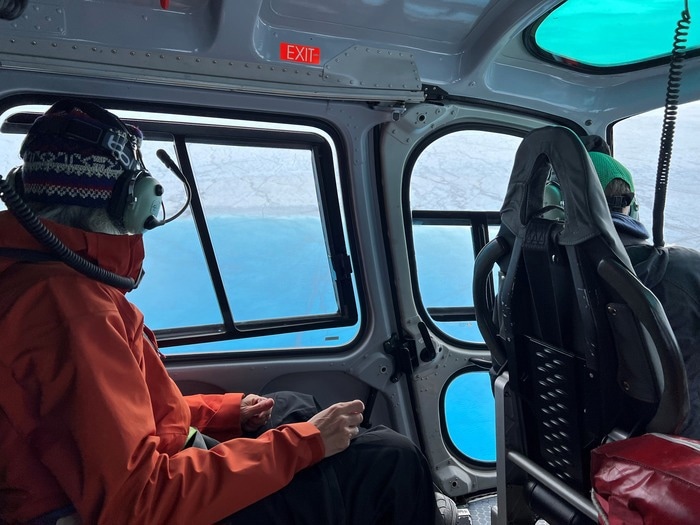Sea levels are rising due to climate change as land ice melts and oceans expand. The occurrence of glacier calving incidents will influence how much and how quickly sea levels rise in the near future.
Associate Professor Laura Stevens (right) and co-author Professor Meredith Nettles (left, Columbia University) approach a Greenland supraglacial lake via helicopter. Image Credit: Marianne Okal (UNAVCO, Inc.).
Large pieces of ice break off from glaciers that end in the ocean (referred to as tidewater glaciers) and fall into coastal fjords as icebergs. The sooner these glaciers flow over the ground towards the ocean, the more ice joins the ocean, hastening sea level rise.
The glaciers of Greenland may melt during the hotter summer months, creating large lakes that could eventually flow through to the glacier’s base. According to research on the inland Greenland ice sheet, this lowers friction between the ice and the land, allowing the ice to slide quicker for a few days.
However, it has been unknown if such draining events impact the flow rate of tidewater glaciers, and thus the rate of calving occurrences, until now.
A study team from Columbia University, the Oxford University Mathematical Institute, and the Oxford University Earth Sciences department used GPS data of the flow speed of Helheim Glacier—the biggest single-glacier contributing to sea level rise in Greenland—to explore this. The GPS recorded high-temporal-resolution data of the glacier’s flow reaction to lake drainage, which was a nearly perfect natural experiment.
The Helheim Glacier was found to operate differently from the inland ice sheet, which moves quickly and downward during lake drainage events. Helheim Glacier, in contrast, showed a very minor “pulse” of movement when the glacier accelerated for a brief time and subsequently slowed down, with no net increase in movement.
The findings indicated that this result was probably triggered by the Helheim glacier having an effective system of channels and cavities along its bed using a numerical model of the subglacial drainage system. This permits draining water to be swiftly drained from the glacier bed without increasing overall net movement.
Although this looks to be good news in terms of sea-level rise implications, the experts estimate that a different result may emerge for glaciers that lack an efficient drainage system and where the surface melt is now low but may grow in the future owing to climate change (such as in Antarctica).
Researchers used a mathematical model built on colder Antarctic tidewater glaciers. The findings suggested that lake drainages under these conditions might increase glacier movement. This was largely attributable to the less effective winter-time subglacial drainage system’s inability to swiftly clear flood waters. However, there have been no in-situ observations of Antarctic tidewater glacier reactions to lake draining to date.
The study puts into question several commonly used methods for estimating glacial drainage networks based on glacier velocities measured by satellite (which are presently employed in sea level rise models).
What we've observed here at Helheim is that you can have a big input of meltwater into the drainage system during a lake drainage event, but that melt input doesn’t result in an appreciable change in glacier speed when you average over the week of the drainage event.
Laura Stevens, Study Lead Author and Associate Professor, Department of Earth Sciences, Oxford University
Lake drainage episodes like the one detected in the Helheim GPS data frequently go unrecognized since the maximum temporal resolution of satellite-derived glacier speeds presently available is around a week.
These tidewater glaciers are tricky. We have a lot more to learn about how meltwater drainage operates and modulates tidewater-glacier speeds before we can confidently model their future response to atmospheric and oceanic warming.
Laura Stevens, Study Lead Author and Associate Professor, Department of Earth Sciences, Oxford University
Stevens, L. A., et al. (2022) Tidewater-glacier response to supraglacial lake drainage. Nature Communications. doi.org/10.1038/s41467-022-33763-2.
Source: https://www.ox.ac.uk/









 Add Category
Add Category

